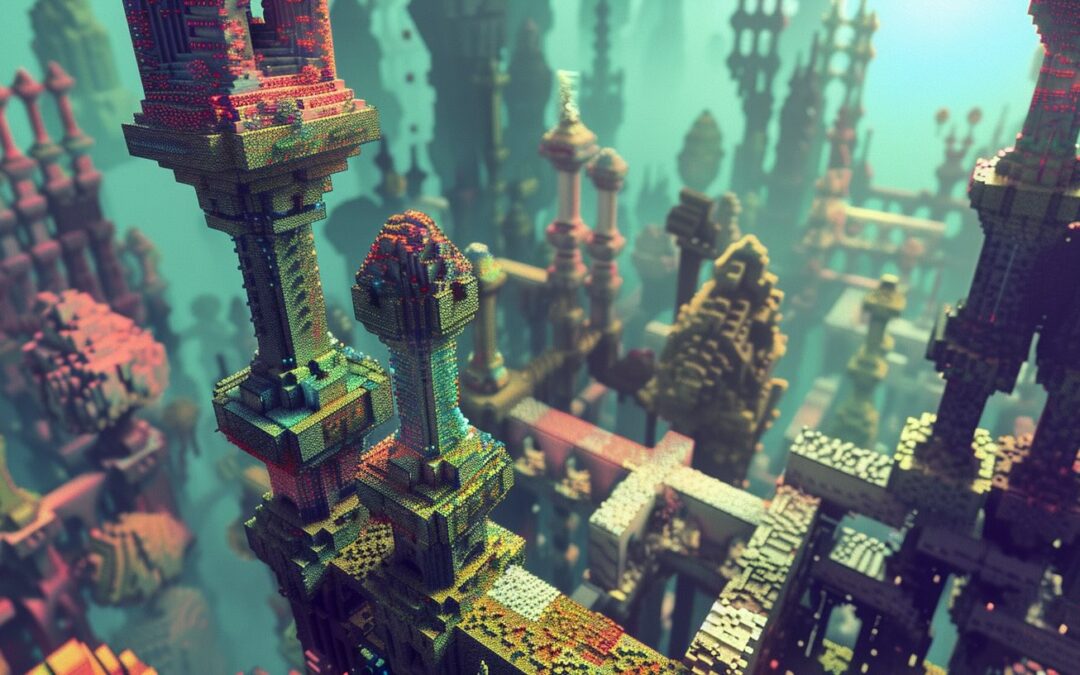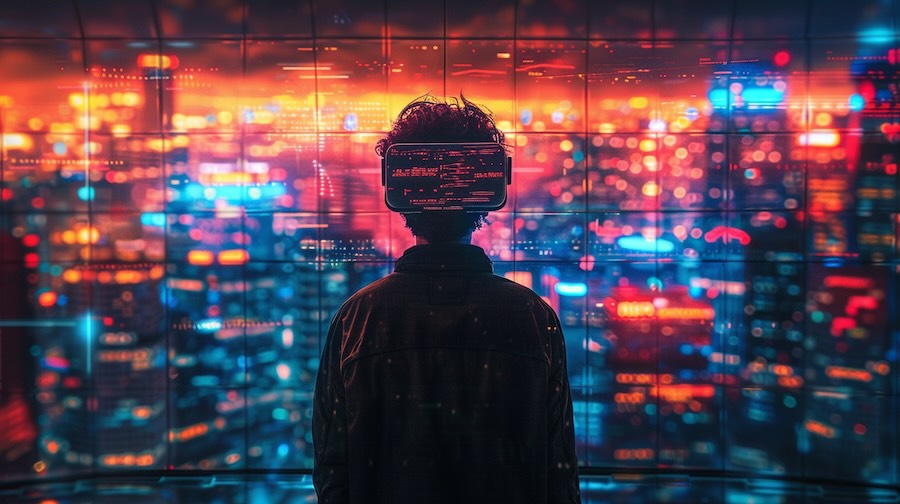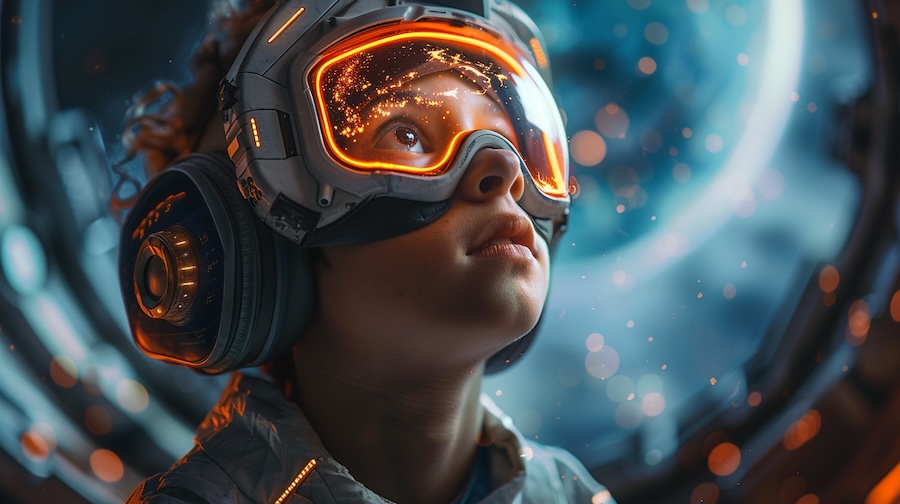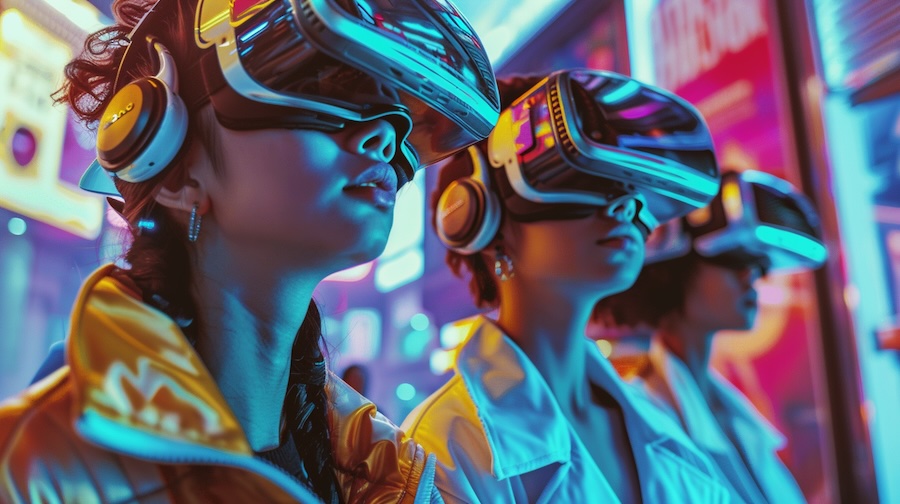We created this blog post for the EU-funded project “V2B: Creating NFT Opportunities on Metaverse for Art VET Trainees”, and our project reference number is 2022-1-DE02-KA210-VET-000080828. Coordinated by L4Y Learning for Youth GmbH in collaboration with Adana Cukurova Guzel Sanatlar and EMC Services Ltd, “Introduction to Creating NFTs on the Metaverse: Opportunities and Challenges” is prepared related to the training framework in the introduction post.
The metaverse, a burgeoning virtual universe of interconnected digital spaces, has emerged as a focal point of technological innovation. Concurrently, NFTs—unique digital assets encrypted on blockchain technology—have revolutionized ownership and transaction systems in our digital era. This unit explores both the vast opportunities and significant challenges that the advent of NFTs in the metaverse presents. Importantly, learners will uncover the transformative potential of NFTs, delve into the new creative avenues they forge, and identify the obstacles that need to be navigated to unlock their full potential. This post is tailored for learners keen on navigating the realms of emerging technologies, digital breakthroughs, and the evolving landscape of online interactions. You can also find more blog posts in our R2 category. It is one of the posts.
Learning Objectives
- Understand the concept of the metaverse and its significance in the digital era.
- Define Non-Fungible Tokens (NFTs) and explain their uniqueness and use cases.
- Identify the opportunities that NFTs bring to creators, artists, and entrepreneurs within the metaverse.
- Analyze the challenges associated with NFT creation, including environmental concerns and intellectual property issues.
- Appreciate the potential impact of NFTs on virtual economies, creative industries, and social interactions within the metaverse.
NFTs in the Metaverse: Introduction
The term ‘Metaverse’ vividly captures the essence of a fully immersive internet experience. In this space, we gain access to both augmented and virtual realities, which opens up a world of interaction with diverse environments. Furthermore, this interaction is facilitated through the use of persistent avatars and cutting-edge digital technology. Consequently, it emerges as a digital landscape. This landscape promises to revolutionize how we interact with each other and the world around us.
The Metaverse holds significant implications for the digital era, actively offering new opportunities for social interaction, community building, and human connection. Furthermore, it possesses the potential to foster new forms of social engagement, community development, and collective action.
As the Metaverse continues to evolve, it becomes crucial for developers, policymakers, and civil society to work together. They aim to address these challenges and promote positive social outcomes. Consequently, achieving this goal requires a multi-stakeholder approach. This approach must bring together diverse perspectives and expertise.
NFTs have many potential use cases, including representing ownership of assets in the metaverse and monetizing content. Some of the top NFT use cases include:
1. Digital Art: Significantly, NFTs have revolutionized the buying and selling of digital art.
2. Gaming: Additionally, NFTs can be used to represent in-game items like weapons, skins, and other virtual goods.
3. Collectibles: Moreover, NFTs can be used to create unique collectibles like trading cards, stamps, and other memorabilia.
4. Music: Furthermore, NFTs can be used to represent ownership of music rights and royalties.
These examples merely scratch the surface of NFTs’ potential in the metaverse. As the Metaverse continues to unfold, it will indeed be fascinating to observe how NFTs further alter our interactions within this digital frontier.
NFTs in the Metaverse: Opportunities
Digital Art and the Metaverse: A New Frontier
There is widespread agreement on the advantages of persistently applying technology, especially in the realm of digital art. Here, technology offers a groundbreaking metric for artists, enabling them to display and sell their artworks to a global audience with minimal barriers. Simultaneously, it allows consumers to enjoy a boundless experience. It is not limited to physical space or museum entrance fees. This article contributes to a broader discussion about the future of digital art and the metaverse and its role in shaping our online culture. [1]
The Evolution of the Web: From Connection to Immersion
The Web first created a connection with everyone in the world at any time. Later, the Internet of Things (IoT) revolution led to a remote connection with devices as well as people. Next, the notion of the semantic web emerged by means of technologies, such as the Resource Description Framework and Web Ontology Language that make Web data more understandable by machines.
This caters to multifarious intelligent applications, including media management and optimised Web search [2], all driven by artificial intelligence (AI) subfields (e.g., machine learning and machine vision). At present, the concept of the metaverse is a vision for the next evolution of the Web, focusing primarily on the type of communication, interaction (namely, 2D to VR/3D) and immersion, brought about at a key moment in time where there is both a visible growing hunger for a VR-driven Web transformation and the technology in place to cater to machine reading of Web content.
Historical Perspectives on Virtual Environments
Yet, the idea of a 3D Web or Metaverse is not a new one. The technological capabilities to create interactive 3D virtual environments have been available for the last 30 years. For example, since 1994, the Virtual Reality Modelling Language (VRML) has enabled the use of vector graphics to be deployed on the Web, supporting the creation of sharable 3D environments. VRML as a browser plug-in is a technology that is still actively used in a broad range of research applications, as demonstrated by Li et al. (marine simulation [3]) and Yan et al. (VR-based education systems [4]) and, within the art and culture domain, Xiaobing et al. employ the technology for ceramic painting and a fusion with virtual reality [5]. Hitherto, with 3D content being graphically heavy, scalability has been a longstanding limitation for widescale updates due to computational boundaries.
This has led to many using existing infrastructure for their 3D worlds, for example the online social game Second Life, which gained prominence in the early 2000s and is still actively used in research [6], as well as Roblox [7] and Minecraft [8]. All three are popular choices, because the cloud infrastructure is already in place to cater to shareability, and users are able to create 3D environments without needing to learn how to code or create their own 3D assets and game world.
The Push for a 3D Web and the Metaverse Today
Hence, there is an organic push towards a 3D Web [9] and this growing interest in the notion of the Metaverse [10] is driving the creation of varied 3D-based platforms and siloed environments for commercial, entertainment, social, and educational purposes. With this notion, Giannini et al. discuss that the digital identity of the museum is evolving alongside human interactions on the Internet [11]. It must also be noted that the COVID-19 pandemic and its accompanying lockdown experiences have acted as catalysts for this evolution, as many galleries and museums have begun to offer alternative virtual visitor experiences [12].
Still, beforehand, the technology was already particularly beneficial for virtual art galleries and cultural heritage applications. It offers the opportunity to preserve aspects of our physical historical sites (in the event of climate change, war, etc.) in a format that is sharable and future-proof, as well as allowing artists to share their creations in a manner that is not just constrained to local visitors, but rather freely accessible to others around the globe. As Kantaros et al. discuss, the 3D Web has a high potential for cultural heritage.
The Intersection of Art, Technology, and the Metaverse
With the rigorous pace of technology involvement, we can expect to see new ways of combining fine art embedded with Web3D services. Further, extended reality services (e.g., virtual reality and augmented reality) and AI provide modern artists with new technics, tools for showcasing their creations to their audiences on 3D digital platforms. As the development of the Metaverse continues, more possibilities for fine art artists are available. The utilization of non-fungible tokens (NFTs), thereby, is revolutionizing the way digital artists, encompassing those in visual and audio media, assert their creatorship of digital content. Furthermore, this innovative technology grants artists the ability to prove ownership and protect their intellectual property rights. Such capability is of paramount importance in the art world, ensuring creators retain control over their work. Additionally, NFTs allow artists to sell their designs as unique, one-of-a-kind digital assets, thereby providing publicly recognisable ownership.
The Business Landscape of the Metaverse
The immersive environment of the metaverse isn’t just an opportunity for consumer-facing companies, however. From training future surgeons to rolling out product demos to retail employees, there are plenty of business applications. With post-Covid hybrid or remote working environments, many of these more creative virtual business experiences are likely to become even more relevant to how companies connect to their people and to their customers. In contrast, the social media landscape is eager to capitalize on the reach of people, where they connect and purchase not just through a traditional internet connection, but in a 3D, immersive metaverse.
Virtual showrooms have the potential to instantly move from extreme experimentation to mass adoption in fashion shows and dressing rooms. And people aren’t just selling physical products, it’s even possible to open a virtual art metaverse gallery. Additionally, new business models, including virtual goods, including non-fungible tokens (NFTs), the only instances of which are exchanged and secured on a blockchain, and trading on physical goods purchased in virtual worlds will gain importance as capabilities scale. [14]. Hence, the ability to authenticate authorship and to sell digital art as distinctive assets is of immense significance in the art industry, and NFTs have opened up new possibilities for artists to monetize their talent and creativity.
The Future of the Metaverse and Digital Ownership
In the rapidly evolving landscape of digital technology, the metaverse has emerged as a concept that captivates both technological visionaries and everyday individuals. A metaverse is an expansive and interconnected virtual space where users can interact, socialize, create, and transact. This paradigm shift in how we perceive and engage with the digital realm has been further augmented by the advent of Non-Fungible Tokens (NFTs), which have introduced a novel dimension of ownership and value exchange.
The Role of NFTs in the Metaverse
At its core, the metaverse represents a convergence of digital spaces, blurring the boundaries between the physical and virtual worlds. Within these immersive environments, NFTs have emerged as a transformative force, enabling users to tokenize and represent ownership of unique digital assets. Unlike cryptocurrencies such as Bitcoin or Ethereum, which are fungible and interchangeable, NFTs are indivisible and distinguishable from one another. This distinctiveness has paved the way for a plethora of opportunities and challenges, creating a dynamic landscape that demands exploration.
Anticipating Challenges and Shaping the Future
In the very near future, we will witness how artists, content creators, and entrepreneurs are using this technology to redefine digital ownership and reshape entire industries. From here, we will also overcome the challenges that arise at the metadata-NFT nexus. These include ecological concerns, the complexities of intellectual property, and the complex balance between market growth and sustainability.
NFTs in the Metaverse: Challenges
Introduction to Metaverse Challenges
The Metaverse concept follows what Kalpokas et al. refer to as a ‘shift to turn online as much of daily life as possible, ultimately leading to the dominance of digital media logistics across the whole society.’ Undergirding the metaverse is, of course, virtual reality, understood in a broader sense than a single experience but, instead, as a multiplicity of virtual worlds. Technically, the metaverse is still a rather long way off. Nevertheless, the economic promises for platforms to effectively monopolise their users are clear, thus driving investment.
The Future of Work in the Metaverse
Considering employment practices more broadly, the metaverse would likely offer new work opportunities or significantly transform existing ones. Notably, the metaverse could make the remote office a mainstay.
Security and Regulation in the Metaverse
In addition to offering multiple opportunities, the metaverse will also feature numerous threats and regulation challenges. To begin, the data necessitated by the metaverse will in itself be a source of threat, in ways that range from surveillance to hacking, also including malevolent sharing of data and the use of data for manipulation.
Cybersecurity Threats and Identity Theft
The metaverse would become a new domain and impetus for cyber-attacks and new forms of identity theft. Notably, ensuring security would become even more difficult owing to the diversity and complexity of the software and technology stack. Also, the metaverse will make it easier for new types of identity theft to happen because virtual copies can be made to fool people.
The Allure and Adaptability of the Metaverse
According to the more enthusiastic voices, the metaverse, combining the features of content streaming, gaming, social media, e-commerce, and any other conceivable domain, should also have the combined appeal of them all. It is crucial to note that the metaverse will be an automatically rendered immersive and adaptive world.
Human-Digital Intertwining in the Metaverse
Thus, referring to the growing intertwining of humans with digital medium where our life, work, sociality and entertainment are becoming increasingly inseparable from the digital realm.
NFTs in the Metaverse: Conclusion
In conclusion, through a comprehensive analysis of these opportunities and challenges, it becomes evident that NFTs are not just digital collectibles but catalysts for profound societal and economic change. Their role extends beyond mere ownership representation; NFTs stand as conduits for the expression of creativity, the cultivation of digital economies, and the transformation of traditional paradigms. The metaverse, with its boundless horizons, beckons us to explore, innovate, and navigate the uncharted territories of NFT building.
As we embark on this journey, let us unveil the potential within the metaverse-NFT ecosystem. While opportunities are abundant, challenges also demand attention. This research paper guides navigating the multifaceted landscape, shedding light on the interplay between technology, creativity, economics, and ethics. Active participation in influencing the future of the metaverse, run by NFTs, requires a balanced understanding of both benefits and drawbacks.
Resources and References
(1) Hurst, W., Spyrou, O., Tekinerdogan, B., & Krampe, C. (2023). Digital Art and the Metaverse: Benefits and Challenges. Future Internet, 15(6), 188. MDPI AG. Retrieved from http://dx.doi.org/10.3390/fi15060188
(2)Sheng, B.; Zhang, C.; Yin, X.; Lu, Q.; Cheng, Y.; Xiao, T.; Liu, H. (2016) Common intelligent semantic matching engines of cloud manufacturing service based on OWL-S. Int. J. Adv. Manuf. Technol., 84, 103–118.
(3)Li, T.; Liu, J.; Xu, Y. (2022) Simulation Research and Development of New Marine Simulator Based on Videotrace. In Applied Mathematics, Modeling and Computer Simulation; IOS Press: Amsterdam, The Netherlands; pp. 58–64.
(4)Gao, Y.; Gao, L.(2022), Realization of Music-Assisted Interactive Teaching System Based on Virtual Reality Technology. Occup. Ther. Int. 2022, 1007954.
(5)Hu, X.; Lai, Y.; Zhao, D.; Tong, F.; Hu, Y.; Li, Y. 2022, Ceramic Painting and Traditional Cultural Element Fusion Composition Design Based on Virtual Reality. Appl. Nanomater. Nanotechnol. Eng. Environ. Life Sci. 2022, 3781448.
(6)Lozano-Durán, A.; Rudolphi-Solero, T.; Nava-Baro, E.; Ruiz-Gómez, M.; Sendra-Portero, F. (2023) Training Scientific Communication Skills on Medical Imaging within the Virtual World Second Life: Perception of Biomedical Engineering Students. Int. J. Environ. Res. Public Health, 20, 1697.
(7)Han, J.; Liu, G.; Gao, Y. (2023) Learners in the Metaverse: A Systematic Review on the Use of Roblox in Learning. Learn. Metaverse Syst. Rev. Use Roblox Learn.,12, 296.
(8)Andrade, B.D.; Poplin, A.; Sena, Í.S.D. (2020) Minecraft as a Tool for Engaging Children in Urban Planning: A Case Study in Tirol Town, Brazil. ISPRS Int. J. Geo-Inf. , 9, 170.
(9)Prins, M.; Gunkel, S.; Stokking, H.; Niamut, O. (2018) TogetherVR: A framework for photorealistic shared media experiences in 360-degree VR. SMPTE Motion Imaging J., 127, 39–44.
(10)Shen, J.; Zhou, X.; Wu, W.; Wang, L.; Chen, Z. (2023) Worldwide Overview and Country Differences in Metaverse Research: A Bibliometric Analysis. Sustainability 15, 3541.










